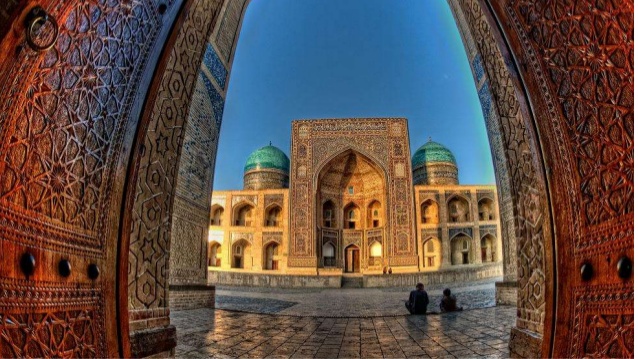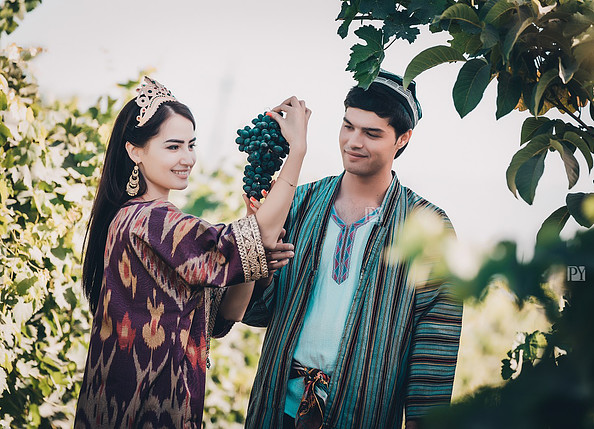Customs and traditions of the Uzbek people are highly distinctive and impressive, dating back to different epochs and religions. Initial formation of Uzbek culture dates back to the 6th-7th centuries BC, when nomadic tribes settled in the valleys of Amu-Darya, Syr-Darya, and Zarafshan, and founded the first states. The territory of modern Uzbekistan, a land between two rivers, being a part of early states, became the basis for the formation of cultures and subsequently, the basis of Uzbek culture.

At the heart of Uzbek culture is its wonderful hospitality, renowned for centuries. Hospitality in Uzbek families is valued more than the wealth of a table and prosperity of the family. Not to receive a guest means to disgrace the family, kin, and mahalla. These caravans would stay for days at a time, enjoying the gracious generosity that has remained a living tradition to the present day.
BESHIK-TUYI. Beshik-Tuyi is a ritual celebration, related to the first time one puts a child in the cradle. Usually it is celebrated on the 7th, 9th, or 11th day from the birth of a child. All relatives, neighbors, and family friends are involved in the preparations for this event. In different regions of Uzbekistan, this ritual has its own peculiarities.
Relatives of the young mother bring “Beshik,” a beautifully embellished wooden cradle, clothes, and everything necessary for a newborn. It is also a custom to bring bread, sweets, and toys, wrapped in clothes. Traditionally, while guests enjoy the holiday table, older women in the nursery carry on the rite of the first swaddling and placing the child into the “beshik.”
WEDDING. Nikokh-Tuyi or wedding in the life of the Uzbeks is of great significance. It is celebrated very richly with splendor and an abundance of guests. Immediate and distant relatives, neighbors, friends, and co-workers are invited to the wedding ceremony. The festivities begin in the early morning with a festal wedding pilaf prepared in the houses of the groom and bride. After the morning pilaf, the groom with friends and relatives, musicians, and dancers come to the house of the bride. The bride in her wedding clothes, today usually in the European white dress, is waiting in the special room, where the imam reads the prayer “nikokh,” which effects a marriage.
MORNING PALOV (Pilaf). Morning pilaf is one of the ancient and obligatory Uzbek rites. It is prepared on the eve of such events as a birth of a baby, wedding, engagement, funeral repast, and other major events.
On the eve of the pilaf there is the small rite of “sabzi tugrar” or carrot chopping. Carrot is one of the main ingredients of the pilaf, along with rice and meat. After chopping the carrots, hosts serve refreshments and the elders distribute duties among men.
Uzbek National Dress. The traditional Uzbek costume remained unchanged until the end of the 19th century. As in all Muslim countries, Islamic values in Uzbekistan were reflected in the style of dress.
The most important part of Uzbek men’s costume was the loose-fitting cotton Chopon, or robe. The robe was long-sleeved, knee length or longer, and made from fabric with a variety of colorful stripes. Wearing two or more robes at the same time was common in both winter and summer, and gave a man a certain prestige while showing the prosperity of the family.
Women’s traditional dress consisted of a tunic, pants, a scarf, and a robe. The long, loose tunic had wide sleeves reaching to the wrists. Loose-cut pants were often made of the same fabric as the tunic, or out of complementary fabric.
Uzbek women covered their heads with headscarves. Very often they wore two scarves: one of them was put over the head, the other was rolled up and wrapped round the forehead. In the 19th century women wore a wimple with an opening for the face. Another scarf, peshona rumol, was wrapped round the forehead, and coiled into a turban at the top. In everyday life they also covered the head with a white muslin scarf, which was sometimes decorated with embroidery.
Head dress. Duppi, skullcap, a round slightly pointed skullcap beautifully decorated with embroidered or applique patterns, is the national head-dress throughout Central Asia. The history of this skullcap is rooted in the remote ages. They say that Islam, which forbade walking in the streets bare-headed, contributed to the custom of wearing this cap. The cap appeared to be rather handy: to wear it on the head one just needs to unfold it, whereas being folded the cap can be easily tucked up in the sash.
Apart from its purely utilitarian function, duppi has always served as decoration. Skillful seamstresses sought real beauty and perfection, thus elevating their handicraft to the level of art.
The most peculiar is the gold embroidered skullcap from the Bukhara region. Its shape is usually round or tetrahedral, with vegetable or geometrical ornaments, decorated with a fringe and elegant tassels. Gold embroidery makes this skullcap look brilliant and festive.


